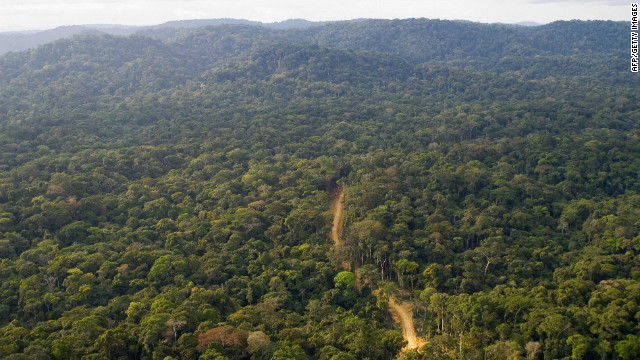Biodiversity is the different varieties is species in a habitat and the different varieties of life. It can be studied on many levels. At the highest level, you can look at all the different species on the entire Earth. On a much smaller scale, you can study biodiversity within a pond ecosystem or a neighborhood park. Identifying and understanding the relationships between all the life on Earth are some of the greatest challenges in science. My group decided to study the West African biodiversity hotspot in order to learn about the different types of species; from mammal to vegetation, and also about West Africa's environmental flaws and climactic differences. A biological hot spot is a natural environment with a high biodiversity that contains a large number of endangered species found no where else on Earth. Twenty five known biological hotspots occupy only 1.4 percent of Earths land surface, but are home to 35 percent of the worlds vertebrate species, and 44 percent of the worlds plant species. A third of Earths known land plants and animals are confined to less than 2 percent of the land surface. In Africa, hotspots include the Guinean forests of West Africa, the island of Madagascar and associated islands in the Indian Ocean, and the Cape Floristic Province of Southern Africa.
The countries and regions that are dealing with the same fate are:
- Sierra Leone
- Liberia
- Cote D'Ivoire
- Guinea
- Ghana
- Togo
- Nigeria
- Cameroon
- Bioko
- Benin
http://www.wbu.com/chipperwoods/photos/hotspots.htm
http://www.nwf.org/Wildlife/Wildlife-Conservation/Biodiversity.aspx

The Guinean Forests of West Africa hotspot encompasses all of the lowland forests of political West Africa, stretching from Guinea and Sierra Leone eastward to the Sanaga River in Cameroon. This includes the countries of Liberia, Ivory Coast, Ghana, Togo, Benin, and Nigeria, which maintain remnant fragments of the forests. The hotspot also includes four islands in the Gulf of Guinea: Bioko and Annobon, which are both part of Equatorial Guinea, and Sao Tomé and Principe, which together form an independent nation. Bioko is a continental-shelf island, whereas the remaining three are oceanic.
The Lowland forests of West Africa are home to more than 20 species of primates.
The Lowland forests of West Africa are home to more than 20 species of primates.
Logging, mining, hunting and human population growth are placing extreme stress on the forests however, threatening species such as the Jentink's duiker pygmy hippopotamus, and scattered populations of western chimpanzees. Five Endemic Bird Area lie partly or entirely within the hotspot. Throughout these forests, there are many different species of mammal, birds, and even plants claiming habitual land.
http://www.microsfere.org/en/ghana/guinean-forests-of-west-africa-biodiversity-hotspot.html
 This food web gives the different patterns that occur in West Africa's food chain. The Jaguar and the Python are at the top of the food chain atop
This food web gives the different patterns that occur in West Africa's food chain. The Jaguar and the Python are at the top of the food chain atop
all of the mammals, reptiles, plants, and bacteria below it. This food web shows that most of the creatures on the food web shows that most animals
are eaten by jaguars, and smaller creatures are eaten by pythons. But as this biodiversity hotspot continues to perish, this food web is at risk of becoming
smaller and putting more animals at risk.

Studying about the Biodiversity hotspot: West Africa, I've learned about the different environment conditions, different species and breeds that lived in that form of habitat, and ways to help that ecosystem so diverse species can live a happier, more open life.
http://www.microsfere.org/en/ghana/guinean-forests-of-west-africa-biodiversity-hotspot.html
all of the mammals, reptiles, plants, and bacteria below it. This food web shows that most of the creatures on the food web shows that most animals
are eaten by jaguars, and smaller creatures are eaten by pythons. But as this biodiversity hotspot continues to perish, this food web is at risk of becoming
smaller and putting more animals at risk.
Studying about the Biodiversity hotspot: West Africa, I've learned about the different environment conditions, different species and breeds that lived in that form of habitat, and ways to help that ecosystem so diverse species can live a happier, more open life.
The Guinean Forests of West Africa biodiversity hotspot is one of the most critically fragmented regions on the planet. Only 93,047 square kilometers, or 15 percent, of its original forest cover remains.
These biologically rich, yet fragile forests are home to an estimated 9,000 vascular plant species, about 20 percent (1,800 species) of which are unique to the region. More than a quarter of Africa’s mammals are also found here, including more than 20 species of primates.
Human activities are placing extreme stress on the forests, with the forests dramatically reduced to a series of fragments separated by agricultural communities and degraded lands. The result threatens not only species but the health of entire ecosystems that provide important benefits for people.
Our support focuses on the Upper Guinean Forest Ecosystem, which stretches from southern Guinea into eastern Sierra Leone and eastward through Liberia, Côte d'Ivoire and Ghana into western Togo.
http://www.cepf.net/where_we_work/regions/africa/guinean_forests/Pages/default.aspx 
I really liked how you included the list of all the places struggling with this issue and how you put added information and facts about hotspots around the world in general.
ReplyDelete